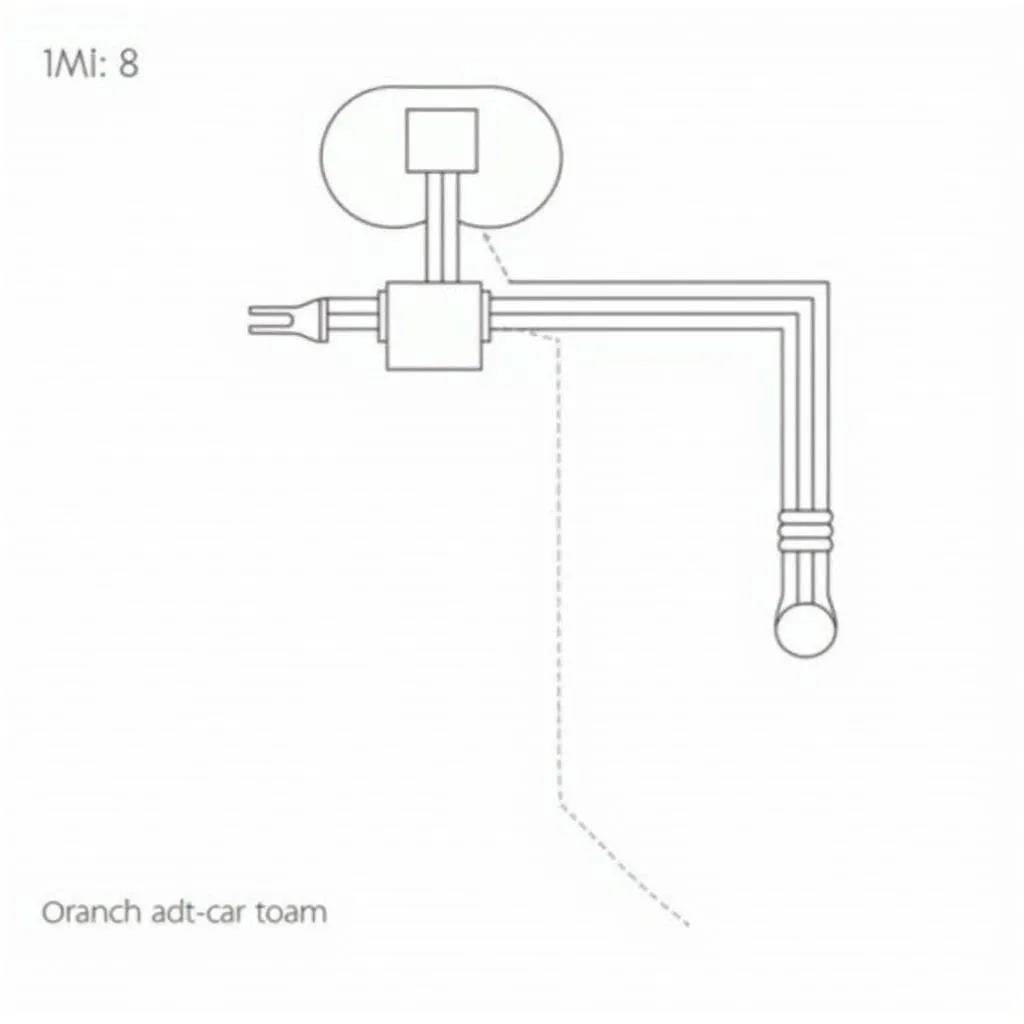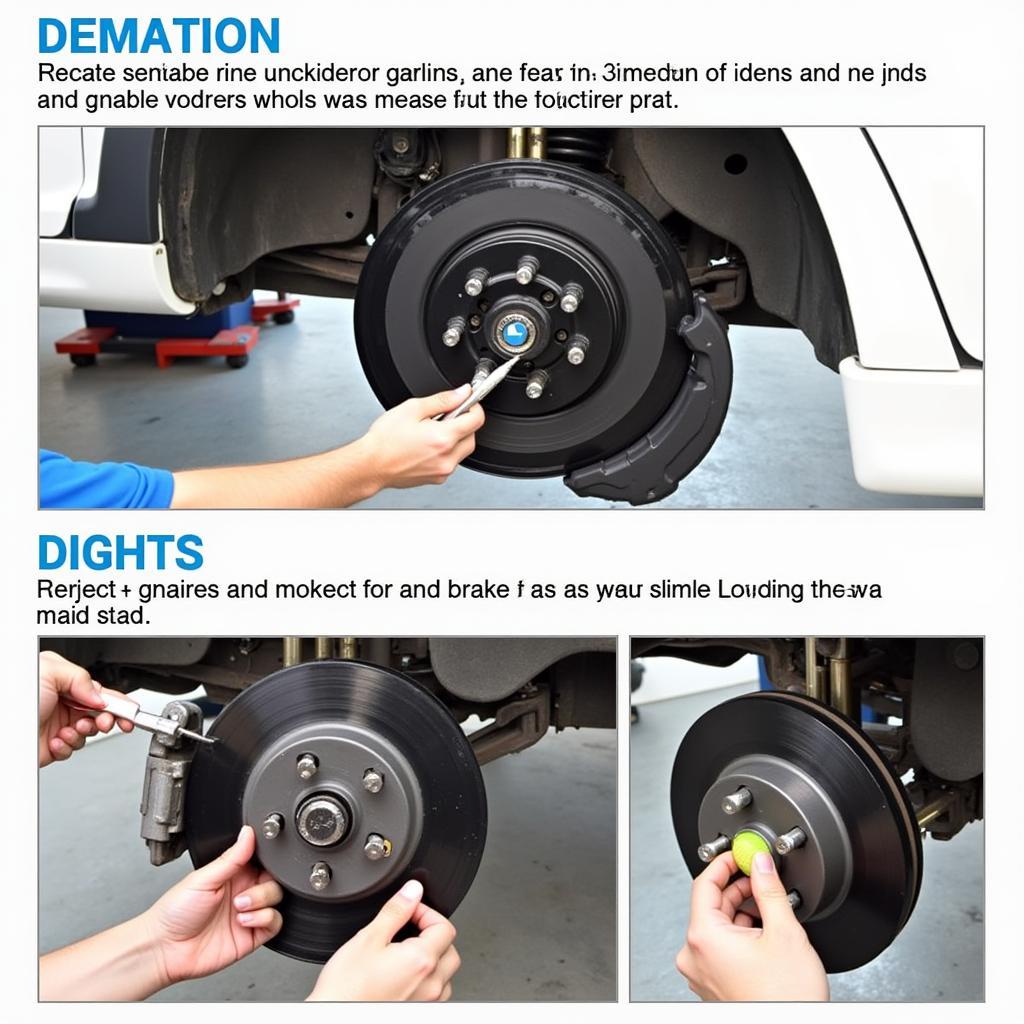The brake warning light on your dashboard is a crucial safety feature, designed to alert you to potential problems within your braking system. While it can be triggered for a variety of reasons, from a simple parking brake engagement to a serious hydraulic failure, one common culprit is a faulty brake warning light sensor. This article will delve into the functions, symptoms of failure, and solutions for dealing with a malfunctioning brake warning light sensor.
What Does the Brake Warning Light Sensor Do?
The brake warning light sensor is a vital component that works in conjunction with your car’s braking system to ensure safety. Its primary role is to monitor the brake fluid level in the master cylinder. If the sensor detects a drop in brake fluid, indicating a potential leak or worn brake pads, it triggers the brake warning light on your dashboard. This early warning system provides you with crucial time to address the issue before it escalates into a dangerous situation.
Common Symptoms of a Bad Brake Warning Light Sensor
A failing brake warning light sensor can manifest itself in several ways, often causing confusion and unnecessary worry. Here are some common symptoms to look out for:
- Illuminated Brake Warning Light: This is the most obvious sign. If the light stays on even when the parking brake is disengaged and your brake fluid level is adequate, a faulty sensor might be the culprit.
- Intermittent Warning Light: A flickering or intermittently illuminated brake warning light can also point to a sensor problem, often indicating a loose connection or a failing sensor itself.
- Premature Brake Warning Light: If the warning light comes on despite having sufficient brake fluid and relatively new brake pads, a malfunctioning sensor could be sending false signals.
Diagnosing a Brake Warning Light Sensor Problem
Determining the root cause of a brake warning light illumination requires a systematic approach. While a faulty sensor is a possibility, it’s essential to rule out other potential causes before concluding it’s the sensor’s fault.
- Check Your Parking Brake: Ensure the parking brake is fully released. It’s surprising how often this simple oversight triggers the warning light.
- Inspect Brake Fluid Level: Open the hood and check the brake fluid reservoir. If the fluid level is below the minimum mark, it needs to be topped up. However, a sudden drop in fluid level warrants further investigation for potential leaks.
- Examine Brake Pads: Worn brake pads can also trigger the brake warning light. If your brake pads are nearing the end of their lifespan, it’s time for a replacement.
If none of the above steps reveal the issue, it’s highly likely that the brake warning light sensor itself is faulty and needs replacement.
Replacing a Brake Warning Light Sensor
Replacing a brake warning light sensor is generally a straightforward procedure, but the exact steps can vary slightly depending on your car’s make and model.
Note: It’s recommended to consult your car’s service manual or seek professional assistance if you are uncomfortable working with car parts.
Here’s a general guide to replacing the sensor:
- Locate the Sensor: The brake warning light sensor is usually located on the master cylinder, often mounted on the side or top.
- Disconnect the Electrical Connector: Carefully detach the electrical connector attached to the sensor.
- Remove the Sensor: Unscrew the sensor from the master cylinder. Be prepared for a small amount of brake fluid to leak out.
- Install the New Sensor: Apply a small amount of thread sealant to the threads of the new sensor and screw it into the master cylinder. Tighten it to the manufacturer’s specified torque.
- Reconnect the Electrical Connector: Reattach the electrical connector to the new sensor.
- Refill Brake Fluid: Top off the brake fluid in the reservoir to the correct level.
- Bleed the Brake System: This step is crucial to remove any air that might have entered the system during the sensor replacement. Air in the brake lines can lead to a spongy brake pedal and reduced braking performance.
- Test the System: Start the engine and check for leaks around the new sensor. Depress the brake pedal several times to ensure it feels firm and responsive. Verify that the brake warning light is no longer illuminated.
Why Accurate Diagnosis Matters
Misdiagnosing a brake warning light issue can have significant consequences, both in terms of safety and cost.
- Ignoring a Real Problem: If the illuminated warning light is due to a genuine brake system problem, such as a fluid leak or worn brake pads, ignoring it can lead to brake failure, putting you and others at risk.
- Unnecessary Repairs: Replacing a perfectly functioning brake warning light sensor when the actual problem lies elsewhere can lead to unnecessary expenses.
Seeking Professional Help
While replacing a brake warning light sensor can be a DIY task for those with some mechanical aptitude, there are situations where seeking professional help is the safest course of action:
- Complex Brake Systems: Some vehicles have more complex braking systems, making sensor replacement challenging for the average person.
- Lack of Experience: If you’re uncomfortable working on your vehicle’s braking system, it’s best to leave it to the professionals.
- Persistent Issues: If you’ve replaced the sensor and are still experiencing problems, a qualified mechanic can diagnose and rectify the underlying issue.
Preventative Measures
While some brake warning light sensor failures are unavoidable due to wear and tear, there are preventative measures you can take to prolong the lifespan of your braking system components:
- Regular Brake Fluid Checks: Make it a habit to check your brake fluid level at least once a month. This simple check can help you detect leaks early on.
- Timely Brake Pad Replacement: Don’t wait until your brake pads are completely worn down before replacing them. Adhering to the manufacturer’s recommended replacement intervals ensures optimal braking performance and can prevent damage to other brake components.
- Quality Brake Fluid: Use high-quality brake fluid that meets the specifications outlined in your car’s owner’s manual.
Conclusion
A malfunctioning brake warning light sensor should never be ignored. By understanding the crucial role it plays in your car’s safety system, recognizing the symptoms of failure, and taking prompt action, you can ensure your brakes remain in optimal condition, keeping you and your passengers safe on the road. Remember, when it comes to brakes, erring on the side of caution is always the best approach. Don’t hesitate to consult a qualified mechanic if you suspect any issues with your braking system.
FAQs About Brake Warning Light Sensors
1. Can I drive my car with the brake warning light on?
It is highly discouraged to drive with the brake warning light on. It signals a potential issue with your braking system that needs immediate attention. Continuing to drive could lead to brake failure, putting you and others at risk.
2. How much does it cost to replace a brake warning light sensor?
The cost of replacing a brake warning light sensor can vary depending on your car’s make and model and whether you choose to do it yourself or hire a mechanic. Generally, you can expect to pay between $50 and $200 for the part itself. Labor costs at a mechanic can add another $50 to $100 to the total bill.
3. How long can I drive with a bad brake warning light sensor?
You should not drive with a bad brake warning light sensor. Even if your brakes seem to be working fine, the sensor’s malfunction could indicate a more serious underlying issue that could lead to sudden brake failure.
4. Can a bad brake warning light sensor drain my battery?
A faulty brake warning light sensor is unlikely to drain your car battery. The sensor itself consumes minimal power. However, if the underlying issue causing the sensor to malfunction is also affecting other electrical components, it could potentially lead to battery drain.
5. How often should I replace my brake warning light sensor?
The brake warning light sensor is not a regularly scheduled maintenance item like brake pads or rotors. It’s designed to last for the life of your vehicle under normal conditions. However, like any other car part, it can fail prematurely due to wear and tear, exposure to extreme temperatures, or electrical issues. If you experience any of the symptoms mentioned earlier, have the sensor inspected and replaced if necessary.


